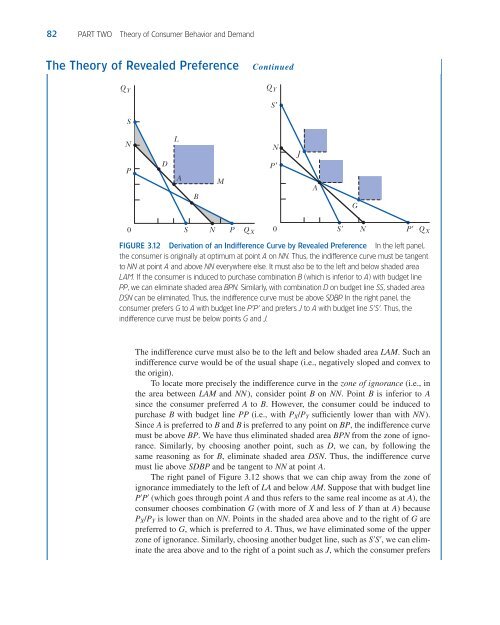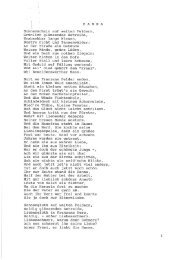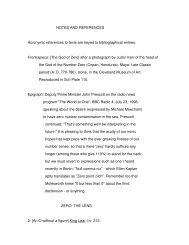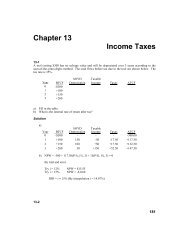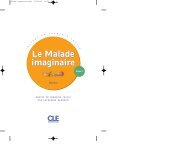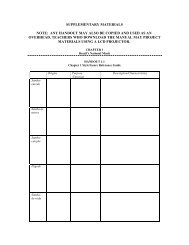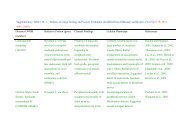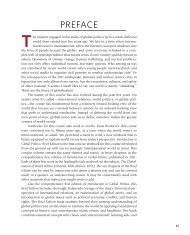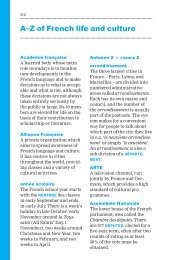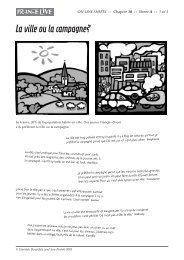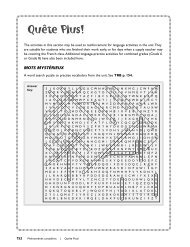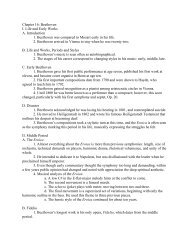CHAPTER 3 Consumer Preferences and Choice
CHAPTER 3 Consumer Preferences and Choice
CHAPTER 3 Consumer Preferences and Choice
You also want an ePaper? Increase the reach of your titles
YUMPU automatically turns print PDFs into web optimized ePapers that Google loves.
03-Salvatore-Chap03.qxd 08-08-2008 12:41 PM Page 82<br />
82 PART TWO Theory of <strong>Consumer</strong> Behavior <strong>and</strong> Dem<strong>and</strong><br />
The Theory of Revealed Preference Continued<br />
Q Y<br />
S<br />
N<br />
P<br />
D<br />
L<br />
A<br />
B<br />
M<br />
0 S N P Q X<br />
Q Y<br />
S9<br />
N<br />
P 9<br />
The indifference curve must also be to the left <strong>and</strong> below shaded area LAM. Such an<br />
indifference curve would be of the usual shape (i.e., negatively sloped <strong>and</strong> convex to<br />
the origin).<br />
To locate more precisely the indifference curve in the zone of ignorance (i.e., in<br />
the area between LAM <strong>and</strong> NN), consider point B on NN. Point B is inferior to A<br />
since the consumer preferred A to B. However, the consumer could be induced to<br />
purchase B with budget line PP (i.e., with PX/PY sufficiently lower than with NN).<br />
Since A is preferred to B <strong>and</strong> B is preferred to any point on BP, the indifference curve<br />
must be above BP. We have thus eliminated shaded area BPN from the zone of ignorance.<br />
Similarly, by choosing another point, such as D, we can, by following the<br />
same reasoning as for B, eliminate shaded area DSN. Thus, the indifference curve<br />
must lie above SDBP <strong>and</strong> be tangent to NN at point A.<br />
The right panel of Figure 3.12 shows that we can chip away from the zone of<br />
ignorance immediately to the left of LA <strong>and</strong> below AM. Suppose that with budget line<br />
P ′ P ′ (which goes through point A <strong>and</strong> thus refers to the same real income as at A), the<br />
consumer chooses combination G (with more of X <strong>and</strong> less of Y than at A) because<br />
PX/PY is lower than on NN. Points in the shaded area above <strong>and</strong> to the right of G are<br />
preferred to G, whichispreferredtoA. Thus, we have eliminated some of the upper<br />
zone of ignorance. Similarly, choosing another budget line, such as S ′ S ′ , we can eliminate<br />
the area above <strong>and</strong> to the right of a point such as J, which the consumer prefers<br />
J<br />
A<br />
0 S9 N<br />
P9 Q X<br />
FIGURE 3.12 Derivation of an Indifference Curve by Revealed Preference In the left panel,<br />
the consumer is originally at optimum at point A on NN. Thus, the indifference curve must be tangent<br />
to NN at point A <strong>and</strong> above NN everywhere else. It must also be to the left <strong>and</strong> below shaded area<br />
LAM. If the consumer is induced to purchase combination B (which is inferior to A) with budget line<br />
PP, we can eliminate shaded area BPN. Similarly, with combination D on budget line SS, shaded area<br />
DSN can be eliminated. Thus, the indifference curve must be above SDBP. In the right panel, the<br />
consumer prefers G to A with budget line P ′ P ′ <strong>and</strong> prefers J to A with budget line S ′ S ′ . Thus, the<br />
indifference curve must be below points G <strong>and</strong> J.<br />
G


